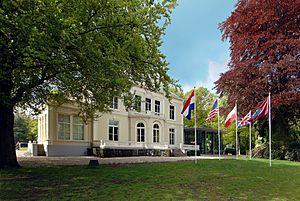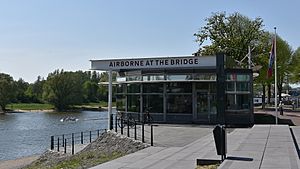Airborne Museum 'Hartenstein' facts for kids

The Airborne Museum Hartenstein, formerly the Hotel Hartenstein and the HQ of 1st Airborne Division during the Battle of Arnhem.
|
|
| Lua error in Module:Location_map at line 420: attempt to index field 'wikibase' (a nil value). | |
| Established | 1949 |
|---|---|
| Location | Oosterbeek, Gelderland, Netherlands |
| Type | Military History |
The Airborne Museum ‘Hartenstein’ in Oosterbeek, The Netherlands, tells the story of the Battle of Arnhem. This important battle happened in September 1944 during World War II. Allied soldiers tried to capture bridges over the Rhine river.
The museum building, Hartenstein, was once the main base for the British 1st Airborne Division. Inside, you can see real weapons, uniforms, and equipment from the battle. Many photos, films, and interviews with soldiers help you understand what happened. The museum also has a special "Airborne Experience" that shows what the area looked like during the fighting. It even shares the views of German soldiers and local people.
Contents
The History of Hartenstein
From Inn to Mansion
Long ago, in 1728, there was an inn called ‘Het Rode Hert’ (The Red Deer) in Oosterbeek. It stood at a busy crossroads. In 1779, a rich lawyer bought the inn and the land around it.
He tore down the inn and built a large mansion with other buildings. He named this new mansion ‘Hartenstein’.
Hartenstein Becomes a Hotel
After the lawyer passed away, ‘Hartenstein’ had many different owners. The building you see today was built in 1865. A coach house was also added next to it.
Later, in 1905, two sunrooms were built onto the villa. Finally, in 1942, the local government bought Hartenstein. They turned it into a hotel.
Operation Market Garden and the Battle of Arnhem
The Plan for Operation Market Garden
After the D-Day landings in June 1944, Allied armies quickly moved through Europe. But their supply lines couldn't keep up, so their advance stopped. A new battle line formed in Belgium and France.
To get around strong German defenses, Field Marshal Bernard Montgomery planned a big operation. British and other Allied forces would capture several bridges in the Netherlands. This plan, called Operation Market Garden, aimed to open a path into Germany.
Why Operation Market Garden Failed
Operation Market Garden took place from September 17 to September 26, 1944. It did not succeed for several reasons. Not enough planes were available to carry all the British and Polish troops on the first day.
Also, the landing zones for the paratroopers near Arnhem were too far from the main bridge. German forces, including strong SS tank units, were also in the area. These German forces were stronger than expected.
Another problem was at Nijmegen. American paratroopers were supposed to capture the bridge there quickly. But they didn't, which delayed other Allied troops for three days. This gave the German army time to strengthen their defenses around Arnhem.
The Battle of Arnhem
More than 10,000 British and Polish soldiers landed near Arnhem. Their goal was to capture the main road bridge over the Lower Rhine river. About 700 men, led by John Dutton Frost, reached the bridge. They held the northern side for four days.
However, most British forces faced very strong German attacks. They became trapped in Oosterbeek. Major General Roy Urquhart made ‘Hartenstein’ his main headquarters during this time.
After nine days of fierce fighting, the Allied division had to retreat. Only about 2,000 of the 10,000 soldiers who landed made it back across the river. The Allies lost the Battle of Arnhem, and ‘Hartenstein’ was badly damaged.
The Airborne Museum
Opening the Museum
Soon after World War II, people wanted to create a museum to remember the battle. In 1949, Doorwerth Castle was chosen as the first location. But the collection of items grew too large for the castle.
So, they looked for a better place. Hotel ‘Hartenstein’, which was a hotel again after the war, was perfect. It was bought and turned into the museum. On May 11, 1978, Major General Roy Urquhart officially opened the Airborne Museum ‘Hartenstein’.
Renovations and New Experiences
In 2008, the museum closed for a big update. A new entrance area and a basement were added. The basement now holds the "Airborne Experience." This exhibit uses detailed displays to show scenes from the battle.
This special exhibit won an award called the Gouden Reiger (The Golden Heron) for its interactive design. In September 2009, on the 65th anniversary of the Battle of Arnhem, the museum reopened.
Every year, the Airborne Museum ‘Hartenstein’ takes part in events to remember the battle. It is a place where veterans, local people, and young visitors can gather. The museum is also near the Arnhem Oosterbeek War Cemetery, where many Allied soldiers are buried. People taking part in the Airborne March parade past the museum each year to honor them.
Free Information Centre "Airborne at the Bridge"

Since 2017, there has been a free information center about the Battle of Arnhem in Arnhem. It is located on the Rijnkade, right across from the John Frost Bridge. The Airborne Museum manages this center.
Visitors can see artifacts and hear stories about the battle for free. A 3D presentation lets you feel like you are experiencing the paratrooper landings. You can also see the advance to the bridge, the British defeat, and the many refugees.



